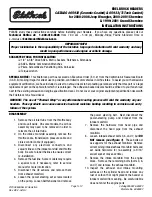
The trailer tongue weight (A) should be 10 percent
to 15 percent of the total loaded trailer weight, up
to a maximum or 400 lbs (181 kg) with a weight
carrying hitch. The trailer tongue weight (A) should
be 10 to 15 percent of the total loaded trailer weight,
up to a maximum of 750 lbs (340 kg) with a weight
distributing hitch.
Do not exceed the maximum allowable tongue weight
for your vehicle. Choose the shortest hitch extension
that will position the hitch ball closest to the vehicle.
This will help reduce the effect of trailer tongue weight
on the rear axle.
After you’ve loaded your trailer, weigh the trailer and
then the tongue, separately, to see if the weights
are proper. If they aren’t, you may be able to get
them right simply by moving some items around in
the trailer.
Trailering may be limited by the vehicle’s ability to
carry tongue weight. Tongue weight cannot cause the
vehicle to exceed the GVWR (Gross Vehicle Weight
Rating) or the RGAWR (Rear Gross Axle Weight
Rating). The effect of additional weight may reduce
your trailering capacity more than the total of the
additional weight.
4-33
Summary of Contents for 9-7X
Page 74: ...NOTES 1 70...
Page 125: ...NOTES 3 3...
Page 126: ...Instrument Panel Overview 3 4...
Page 268: ...When you open the hood on the 5 3L V8 engine here is what you will see 5 14...
Page 270: ...When you open the hood on the 6 0L V8 engine here is what you will see 5 16...
Page 378: ...NOTES 5 124...
Page 393: ...Engine Drive Belt Routing 4 2L V6 Engine 5 3L V8 and 6 0L V8 Engines 6 15...
Page 412: ...NOTES 7 16...
















































